How to Choose a Blog Niche That Actually Works for You
Saqib Gilani
August 7, 2025
Over 7.5 million blog posts go live every single day, but most never get seen. Not because the content is bad — but because the niche was not right. Choosing the right blog niche is the first big step that decides whether your blog will grow or disappear.
Celina spent three weeks jumping between ideas — food blog, personal development, and parenting. She started one, gave up, then started another. Like many new bloggers, she did not know how to choose a blog niche that worked for her. The problem was not her ideas — it was the lack of a clear process.
If you have felt stuck like Celina, you are about to learn how to fix that.
What you need is a clear, simple way to choose a niche that fits you — and that’s exactly what you will get here.
Why Choosing the Right Blog Niche Matters
Your niche decides who reads your content, how well it ranks, and even how much you can earn. A well-defined niche helps you stay focused, build trust, and stand out in a crowded space.
The niche is your blog’s identity. It helps Google understand where your content fits.
Why the Right Niche Matters
Picking the right niche is key to your success.
1. Helps You Attract the Right Audience
2. Builds Authority and Trust
3. Boosts SEO and Rankings
4. Keeps You Motivated
5. Opens the Door to Monetization
Real Stats That Show the Impact of Choosing the Right Niche
- 70% of high-earning bloggers report that choosing the right niche was the most important decision they made in the beginning. (Source: GrowthBadger Blogging Survey)
- Niche blogs generate 2x more traffic than multi-topic blogs in competitive markets. (Source: HubSpot)
- Blogs that focus on a single niche see higher conversion rates from both ads and affiliate links.
Align Your Niche with What Matters
Don’t just think about what’s popular. Think about three things when you choose a niche:
- What you enjoy writing about
- What people are searching for
- What has potential to make money or build your brand
Why is choosing the right blog niche important?
Choosing the right blog niche helps you attract the right audience, rank better in search engines, stay motivated, and grow your blog faster. It builds trust and makes it easier to turn readers into loyal followers or customers.
Recent Post
Get in Touch
Let’s talk about your project. Have a question for us?
Please click on the button below and fill the form to reach us.
Categories
Understanding Blog Niches
What Is a Blog Niche and Why Is It Important?
A blog niche is the main topic your blog is built around. It’s the specific subject you will write about again and again — like plant-based recipes, budget travel for students, or fitness tips for new moms.
Instead of covering everything, a niche helps you stay focused and talk to a clear group of readers.
Think of your blog niche as your “lane.” The clearer it is, the easier it is for people and search engines to follow you.

Benefits of Choosing a Niche
Having a niche helps your blog grow faster. Consider the following benefits:
- Clear content strategy
You know what to write and don’t waste time chasing random ideas. - Stronger connection with your audience
When readers feel like your blog “gets them,” they come back for more. - Better SEO performance
A focused blog builds topic authority, ranks higher in Google, and drives more targeted traffic. - Higher chance of monetization
Brands and affiliates love blogs with a loyal, niche-specific audience. - Less overwhelm
You avoid content burnout by sticking to what matters most to you and your readers.
Why Do You Need a Niche for Your Blog?
- It’s not a good idea to write about everything. When your blog is too broad, it:
- Confuses your audience
- Fails to build expertise or trust
- Struggles to rank in search results
- Attracts low-quality or random traffic
General vs. Niche Blog
Let’s compare two blogs to see the difference:
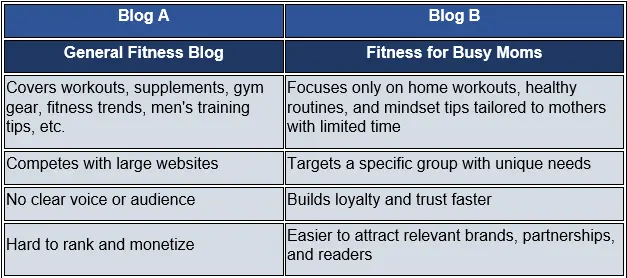
🎯 Niche blogs speak to a specific reader. That’s what makes them powerful.
Step-by-Step Process - How to Choose a Blog Niche
Start with your interests and skills
List topics you enjoy, know about, or are willing to learn.
Think about your goals
Your niche should match your purpose like blogging for fun, personal growth, or to make money.
Understand your audience
Who do you want to reach? What are their needs, problems, or questions?
Check search demand
Use tools like Google Trends, Ubersuggest, or Ahrefs to see if people are searching for your niche topics.
Look at the competition
Search your niche on Google. Are there too many big websites? Look for gaps or areas with low to medium competition.
Validate profitability
Check if there are products, services, or affiliate programs related to your niche. Can you monetize in the future?
Narrow it down
Don’t go too broad. Instead of “health,” try “natural health tips for women over 40.”
Make sure it’s sustainable
Ask yourself: Can I write 50+ blog posts on this topic without losing interest?
Test your idea
Write a few sample posts or talk to potential readers. Get feedback before going all in.
Brainstorming and Generating Blog Niche Ideas
With the right mindset and tools, you can brainstorm ideas that align with your passion, experience, and market demand. This section walks you through how to generate blog niche ideas step-by-step.
How to Brainstorm Blog Niche Ideas
If you are asking yourself, “What should I blog about?”, start by looking inward. The best blog niches are often hiding in plain sight — your own life, knowledge, and experiences.

🔹 Start with What You Know and Love
Begin by jotting down:
- Your interests and hobbies (e.g., hiking, budgeting, home decor)
- Your skills and professional background (e.g., teaching, coding, marketing)
- Life experiences (e.g., parenting twins, overcoming debt, moving abroad)
👉 Why this matters: A niche rooted in your expertise or passion makes it easier to stay consistent and create meaningful, trustworthy content.
🔹 Ask Yourself the Right Questions
- What problems do I enjoy solving?
- What topics do people often ask me about?
- If I could teach one thing for free all day, what would it be?
These self-reflective questions help you discover content areas where you can offer real value.
🔹 Use a “Mind Mapping” Approach
Create a visual web starting with a broad category you love (e.g., “health”). Branch it into sub-niches (e.g., “mental wellness for college students” or “low-impact workouts for seniors”). This is a great way to refine a general topic into a profitable niche.
Creative Approaches to Finding Niche Ideas
Once you have explored your personal interests, it’s time to research market demand and opportunities. Use data-driven tools and online communities to validate your ideas and find what audiences are actually searching for.
🔸 Use Google Trends
Google Trends helps you discover what people are currently searching for. Type in a broad topic and explore:
- Rising queries
- Related topics
- Regional interest
Example: Open Google Trends. Type “budgeting”. It may reveal sub-niches like “budgeting for single moms” or “zero-based budgeting.”
🔸 Explore AnswerThePublic
This tool generates hundreds of real search queries related to any keyword. It gives you insights into what people are asking, which is gold when defining a niche around specific needs or pain points.
🔸 Search Reddit and Quora
In Reddit and Quora, search forums and communities for recurring questions, frustrations, or passions. Look for niche communities like:
- r/FrugalLiving
- r/Minimalism
- Quora spaces on “health anxiety,” “remote work,” or “digital marketing for beginners”
If a topic has a passionate audience and lots of recurring questions, it’s a good sign of niche potential.
🔸 Analyze Popular Blogs
Visit successful blogs in categories you are interested in. Take note of:
- Recurring content themes
- Blog post categories
- Audience engagement (comments, shares)
Ask yourself: Can I offer a unique angle or go more specific than they do?
🔸 Use Social Media Trends
Check trending hashtags on platforms like Instagram, TikTok, or X (formerly Twitter). These give real-time insight into what’s hot and who’s interested.
Example of Hashtags:
- #MindfulEating → niche idea: Mindful eating for busy professionals
- #DigitalNomad → niche idea: Budget travel for remote freelancers
🎯 Next Step: Once you have brainstormed 5–10 potential blog niches, the next phase is validating them based on audience interest, market demand and profitability.
Researching and Evaluating Blog Niches
Now you need to know if your niche has real potential. It’s not just about what you love—it’s about what people are searching for and whether you can realistically stand out. This section walks you through how to research and evaluate blog niches with tools, data, and actionable steps.
🔍 Using Analytical Tools to Choose the Right Niche
A blog niche selection is not a guessing game—it’s a data-driven process. Analytical tools help you understand what people are searching for, how competitive a niche is, and if it’s worth your time.
Here’s how to do it step-by-step:
- Start with Keyword Research Tools:
- Use Google Keyword Planner, Ahrefs, Ubersuggest, or SEMrush to explore keywords related to your niche ideas.
- Look for:
- Search Volume (SV): Are people actively searching for these topics?
- Keyword Difficulty (KD): How hard is it to rank for those keywords?
- CPC (Cost Per Click): High CPC can indicate strong monetization potential.
- Check Related Searches and Questions:
- Use Google’s “People Also Ask”, Autocomplete, and Related Searches to find LSI keywords and content angles.
- Tools like “AnswerThePublic” and “AlsoAsked” reveal real user queries for voice search optimization.
- Check Related Searches and Questions:
- Use Google’s “People Also Ask”, Autocomplete, and Related Searches to find LSI keywords and content angles.
- Tools like “AnswerThePublic” and “AlsoAsked” reveal real user queries for voice search optimization.
- Validate Search Trends:
- Use Google Trends to confirm if interest in your niche is growing, stable, or declining.
- Look at interest by region to target specific demographics.
- Use long-tail keywords like “budget travel tips for families” instead of broad ones like “travel” or “travel tips” to reduce competition and attract a specific audience.
📊 Evaluating Market Demand and Monetization Potential
A niche is only worth pursuing if it has an active audience and monetization opportunities. Here’s how to gauge both:
- Explore Audience Demand:
- Visit Quora, Reddit, Facebook Groups, and online forums related to your niche.
- Look for:
- Frequently asked questions.
- Common pain points.
- Topics with high engagement (likes, shares, comments).
- Use Surveys and Polls:
- Ask your network or audience what they struggle with using Google Forms, Typeform, or Instagram polls.
- Analyze Monetization Channels:
- Is the niche aligned with affiliate programs (like Amazon, ShareASale, or niche-specific networks)?
- Can you create digital products (ebooks, courses, templates)?
- Are brands actively sponsoring blogs in this niche?
👉 Example: “Parenting tips” may have a large audience, but “positive parenting strategies for toddlers” is more targeted—and easier to monetize with ebooks or sponsored toy reviews.
🥇 Assessing the Competition
If there is too much competition, ranking is hard. If there is too little, there may be no audience. That’s why finding the right balance is important when checking your competition.
Let me tell you how to size up your competition:
- Spy on Top Blogs in Your Niche:
- Search your main keywords on Google and check out the top-ranking blogs.
- Observe:
- Content quality and depth.
- Posting frequency.
- Engagement (comments, shares).
- Identify Gaps You Can Fill:
- Check if they lack personal storytelling. You can add that.
- If they are ignoring beginners, you should create beginner-friendly content.
- If their content is outdated, you can update and improve your content.
- Use Competitive Analysis Tools:
- Tools like SimilarWeb, BuzzSumo, and Ahrefs Site Explorer help you analyze your competitors’ traffic, backlink profiles, and top content.
If someone asks, “What’s the best blog niche with low competition?”—answer directly in your content:
“A great blog niche with low competition and solid demand is ‘eco-friendly parenting for toddlers,’ combining sustainability and parenting into a growing topic.”
✅ Quick Checklist to Evaluate a Blog Niche
Use this checklist for a quick yes/no guide:
- Are people actively searching for this topic?
- Is the niche trending or stable?
- Is there room to rank with quality content?
- Are there monetization opportunities?
- Do you feel excited and knowledgeable about it?
If you checked at least 4 out of 5 — your niche has potential.
Don’t skip this research phase. Picking the right niche backed by real data can save you months—or even years—of wasted effort.
In the next section, we will explore profitable and monetizable niches with confidence.
Profitable and Monetizable Blog Niches
If you are serious about turning your blog into a sustainable income stream, then selecting a monetizable blog niche is a smart move.
What Makes a Niche Profitable?
A profitable niche is one that:
- Has consistent audience interest (evergreen topics).
- Solves real problems for people.
- Offers multiple monetization opportunities (ads, affiliates, products, etc.).
Let’s break this down.
🔁 Evergreen and High-Demand
Evergreen niches are those that never go out of style. People are always looking for:
- Ways to save or make money (e.g., personal finance).
- Health tips to feel better or live longer.
- Tech updates to keep up with digital trends.
- Relationship advice, parenting tips, or productivity hacks.
These topics generate steady traffic year-round, which makes them ideal for monetization.
💡 Examples of Profitable Niches
Here are a few blog niches with proven income potential:
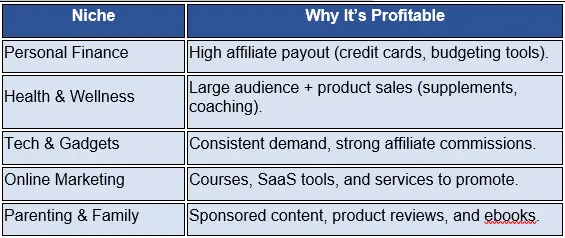
Tips for Identifying Monetizable Niches
If you are not sure whether a niche will make money, use these tips to evaluate monetization potential.
1. Check Affiliate Programs
Use affiliate networks like:
- Amazon Associates
- ShareASale
- ClickBank
- Impact
Search for products or services relevant to your niche. If there are plenty of high-quality, in-demand products, that’s a good sign.
2. Look at Google Ads Potential
Use Google Keyword Planner or Ahrefs to:
- Check CPC (Cost-Per-Click) rates. Higher CPC often means more ad revenue.
- Explore what advertisers are spending on that niche.
3. Explore Niche Product/Service Demand
Ask yourself:
- Are there digital products (courses, ebooks) people are buying in this niche?
- Do brands or companies regularly sponsor blog content in this space?
- Can I create a membership site or exclusive content around this niche?
If the answer is yes to any of these, the niche likely has strong income potential.
Combining Interests and Adapting to Changes
You don’t always have to choose one topic—mixing your interests and following new trends can work even better.
This section guides you through how to merge multiple interests creatively and future-proof your blog niche.
How to Combine Multiple Interests into One Blog Niche
Not all great blogs stick to a single subject. In fact, some of the most successful blogs are born at the intersection of two or more topics. Here’s how to do it smartly:
- Identify common ground between interests
List your passions and look for overlap. For example, love for cooking and photography could evolve into a blog about “Food Styling for Social Media.” - Target a specific audience
Combine interests in a way that serves a defined group. Think “Fitness Tips for Busy Parents” or “Remote Work Tools for Creatives.” - Focus on unique positioning
The more original your angle, the easier it is to stand out. Merging niches allows you to own a less competitive micro-niche with a loyal audience.
Examples of Successful Hybrid Blog Niches:
- “Vegan Recipes for Travelers” – Combines food blogging with travel.
- “Mindful Tech for Parents” – Merges parenting, wellness, and technology.
- “Adventure Finance” – Mixes outdoor lifestyle with personal finance.
Adapting Your Blog Niche Over Time
Even if you pick the right niche today, market dynamics, reader interests, and your own passions can change. A great blogger evolves with time—here’s how you can do that too:
- Monitor content performance regularly
Use tools like Google Analytics or Rank Math to assess what content resonates most. This insight helps you fine-tune or pivot topics without losing your audience. - Stay updated on industry trends
Subscribe to newsletters, explore subreddits, and follow influencers in your niche. This helps you spot opportunities early and adjust your content accordingly. - Experiment with new formats or sub-niches
Test new content within your existing theme. For instance, a travel blogger might start including eco-tourism tips as sustainable travel gains popularity. - Know when to rebrand
If your original niche feels restrictive or outdated, it’s okay to expand or shift focus. Just ensure your audience is part of the journey through clear communication and gradual transitions.
Common Mistakes and Pitfalls to Avoid
It is a crucial step to choose a blog niche—but getting it wrong can cost you time, traffic, and motivation. If you are just starting or trying to refine your current niche, you must know what mistakes to avoid. It can help you build a stronger foundation and a blog that actually grows.
Top Mistakes Beginners Make When Choosing a Blog Niche
Many new bloggers rush into picking a niche without doing enough thinking or research. Here are the most common errors:
1. Going Too Broad
If you blog about “lifestyle” or “everything I love”, you might feel free. But it confuses both your readers and search engines. A niche that’s too broad waters down your authority and makes it harder to stand out.
Example: Instead of blogging about “health,” narrow it to “plant-based diets for beginners.”
2. Going Too Narrow
The opposite mistake is choosing a niche so specific that there is barely any audience. While niche-down advice is helpful, it should still have room to grow and attract a community.
To avoid this mistake, use keyword research tools to estimate search volume before committing.
3. Ignoring Your Audience’s Needs
Your blog should serve your readers—not just your personal interests. If you don’t consider what problems people are trying to solve, you risk creating content no one is looking for.
4. Skipping Market Research
Many bloggers jump into writing before checking if there is an audience, competition, or monetization potential in the niche.
How to Avoid These Common Challenges
A blend of planning, research, and adaptability is required to prevent these mistakes. Here’s how to stay on track:
Steps to Balance Passion and Profitability
Follow the below steps to find sweet spot between what you love and what actually pays:
- Start with what excites you
Think about the topics you can talk about for hours or research without getting bored. Your passion will fuel consistent content — and that matters. - List problems you can solve
Every profitable blog helps someone. Ask yourself: What questions can I answer? What problems can I help solve? - Validate your ideas with real data
Use tools like Google Trends, Ubersuggest, or even Reddit to see if people are searching for your topic. If no one’s looking for it, it’s hard to build traffic. - Look for existing monetization paths
Check if there are affiliate programs, digital products, or sponsored content opportunities in your niche. See how others are making money. - Check the competition
If the competition is too much, you might get buried. If it is too little, there may not be a market. A healthy amount of competition usually means there is money on the table — and room for one more if your content stands out. - Test before committing fully
Write 5–10 blog posts and monitor which topics perform best. Sometimes your most profitable content might surprise you. - Adjust as you grow
Don’t be afraid to evolve. As you understand your audience better, you can lean into the topics that get the best results — while staying true to your core passion.
Pro Tip:
You don’t need to be obsessed with the topic 24/7 — but you do need to care enough to stay consistent and deliver value. That’s where real growth (and income) happens.
Use Feedback and Analytics
Check how your content performs. Tools like Google Analytics, Search Console, and Hotjar help you understand user behavior and adjust your content strategy.
If your posts on “budget skincare” get more traffic than “luxury product reviews,” pivot accordingly.
✅ Stay Updated with Trends
Use platforms like Google Trends, Reddit, and YouTube to track what’s trending in your niche and find new angles your audience cares about.

Examples and Real-Life Inspiration to Help You Choose a Blog Niche
Sometimes the best way to move forward is to look at those already a few steps ahead. Real-world examples can give you the clarity and motivation you need to carve out your space online. If you are searching for blog niche ideas or curious how others turned their passion into income, these case studies will show you what works and why.
1. Minimalist Baker – Simple Recipes with Big Impact
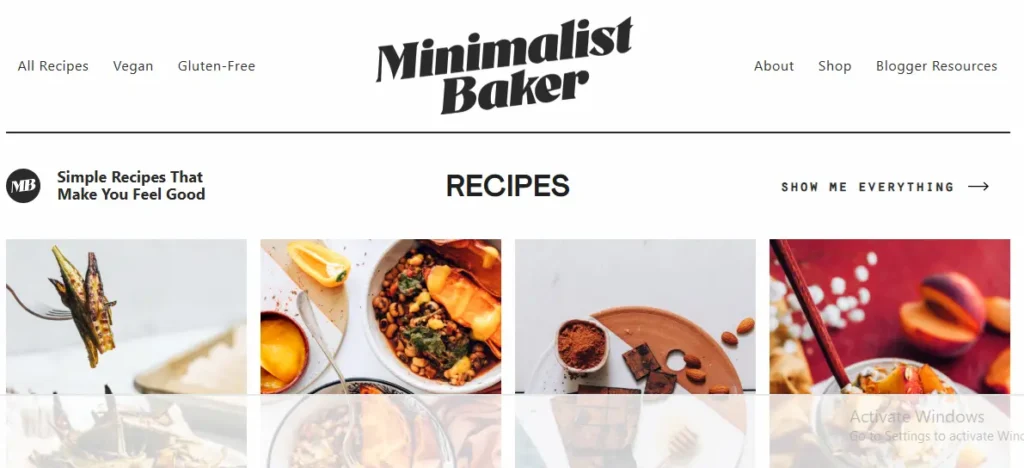
Niche: Vegan and gluten-free recipes using 10 ingredients or less.
Why it works:
- Laser-focused audience: People with dietary preferences or restrictions.
- Clear value promise: Quick, simple recipes — exactly what the reader expects.
- Smart monetization: Cookbooks, ads, affiliate products, and sponsored posts.
- Visual consistency: Clean, minimalist branding that builds trust instantly.
A niche doesn’t have to be huge — it just has to solve a real need consistently.
2. Nerd Fitness – Fitness for the Not-So-Fit Crowd
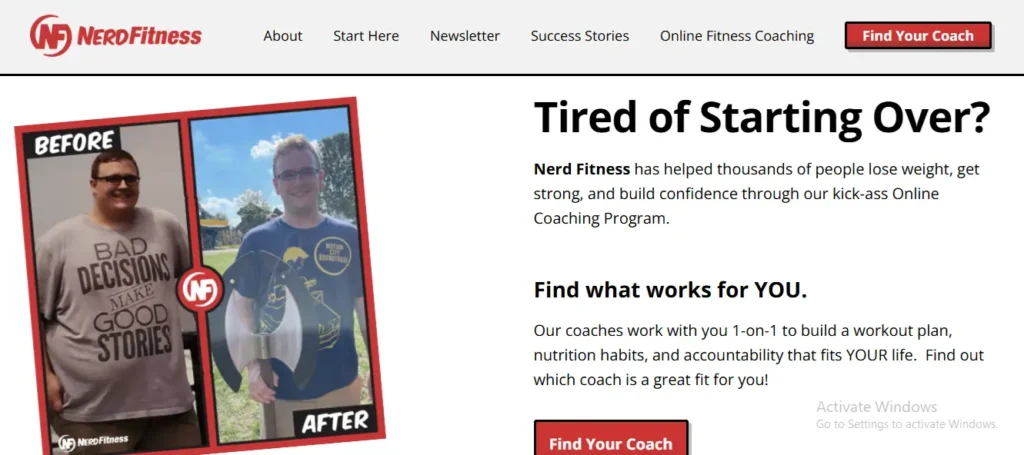
Niche: Fitness advice for geeks, gamers, and self-proclaimed introverts.
Why it stands out:
• Unique voice and storytelling: Pop culture references + relatable tone = loyal tribe.
• Community-driven: Forums, challenges, and accountability groups.
• Monetization: Online coaching, digital products, and memberships.
When you blend personality with purpose, even saturated niches like fitness can feel brand new.
3. The Points Guy – Travel Meets Credit Card Strategy
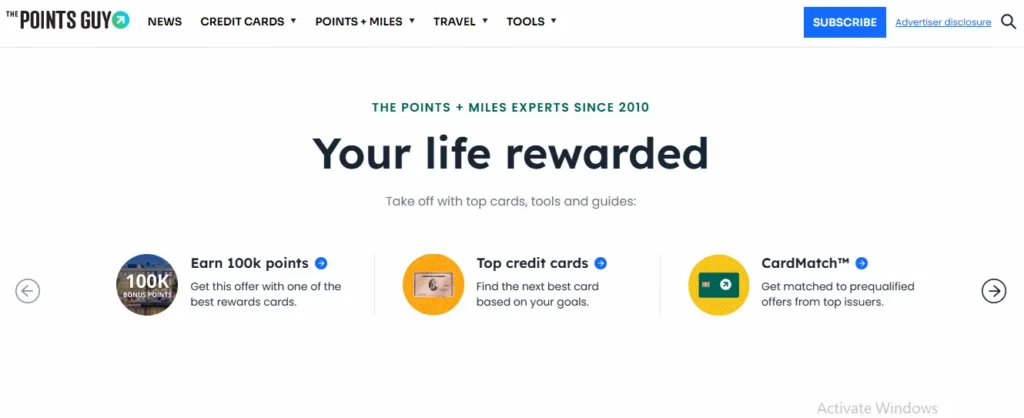
Niche: Maximizing credit card points and airline miles for free or discounted travel.
Why people love it:
- Deep-dive content: Detailed guides on maximizing travel rewards.
- Evergreen + trending topics: Constant updates keep content relevant.
- Affiliate marketing powerhouse: Commissions from credit card referrals.
A blog can educate and earn — if you are solving complex problems with clarity.
4. Budget Bytes – Affordable Cooking for Everyone
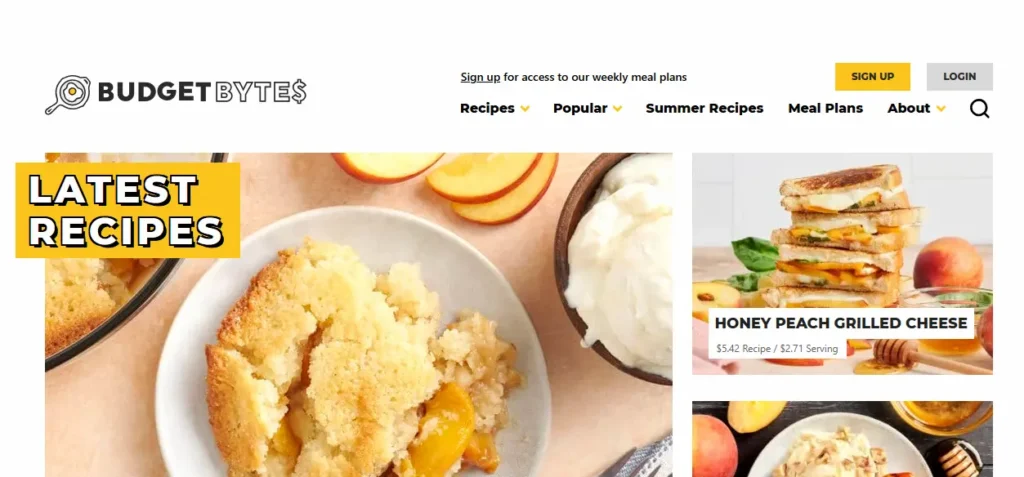
Niche: Budget-friendly recipes for everyday meals.
Success formula:
- Broad appeal, specific focus: Affordable food resonates with students, families, and solo cooks.
- Helpful breakdowns: Cost per recipe, nutritional info, and visual guides.
- Multiple income streams: Ads, partnerships, and a best-selling cookbook.
You don’t have to invent something new — just present it in a more useful, accessible way.
5. Frugalwoods – Financial Independence Through Simple Living

Niche: Frugal living, financial independence, and rural homesteading.
Why it connects deeply:
- Authentic voice: The blog tells a real family’s journey — no filters.
- Content that inspires action: Readers are motivated to rethink spending.
- Monetization: Book deals, speaking, and affiliate links.
Personal stories, when told honestly, can turn into powerful content — and a full-time income stream.
Tips to Find Your Unique Angle (Even in a Crowded Niche)
You have seen what works for others. Now it’s time to define what will work for you.
✅ Use Your Personal Story
Your experiences, struggles, and wins cannot be copied. Share them. Whether it’s your journey with anxiety, parenting twins, or saving your first $10K — it creates emotional connection and trust.
How can I make my blog stand out?
—> Answer: Tell your story. Readers connect with real-life experiences more than generic advice.
✅ Blend Two Passions
If you cannot pick between two topics, combine them!
Example: Fitness + Tech = A blog on fitness wearables and apps.
This gives you a fresh perspective others might not have explored yet.
✅ Focus on a Specific Group
Instead of “travel,” try “budget travel for students” or “luxury travel for couples over 40.”
The narrower your audience, the easier it is to speak their language and rank for specific search terms.
✅ Answer One Core Question
What single, powerful question does your blog answer?
If your content keeps circling back to solving that, you are already building a niche — even if it doesn’t feel like it yet.
Inspiration Is Everywhere — If You Know Where to Look
The perfect niche isn’t about chasing trends — it’s about solving real problems, in your own voice, for a group of people you care about.
Let these examples guide you, but don’t copy them. Instead, ask yourself:
- What unique value can I bring?
- Who do I genuinely want to help?
- What topic can I stick with long enough to make it work?
Answer those honestly, and you are on your way to building a blog that’s not just profitable — but purposeful, too.
Your downloadable worksheet for brainstorming blog niches is ready
Use it to discover a niche that aligns your passion with profit potential.
Recap of Key Takeaways: Turn Your Blogging Dreams into a Clear, Profitable Reality
Let’s quickly recap what we have covered so far—because clarity is the first step toward confident action:
- Start with your interests: Brainstorm ideas that excite you and align with your skills or knowledge.
- Validate your niche: Use keyword research tools, explore market demand, and observe trends in your target audience.
- Think about profitability: Consider potential monetization options—affiliate marketing, digital products, coaching, or sponsorships.
- Avoid common mistakes: Don’t go too broad, skip audience research, or follow only your passion without testing the market.
- Balance passion and income: Find the sweet spot between what you love and what people are willing to pay for.
- Get inspired: Learn from real-life examples and use storytelling to carve out your unique space online.
These are not just theoretical steps—they are practical, proven actions that can guide you toward building a blog with purpose and potential.
🚀 Take the First Step Now
Don’t wait for the perfect moment. Just start by writing down 10 niche ideas that combine your interests and what others care about. From there, expand your research and see which ones stand out.
So, what’s stopping you?
Your audience is out there, waiting. Your ideas are valid. Your voice matters.
Now go out there and start something worth sharing.
FAQs (Frequently Asked Questions)
How do I define a niche for my blog?
To define a niche for your blog:
- List your interests, skills, and experiences
- Think about the people you want to help
- Combine your passion with what people are searching for
- Narrow it down to one clear topic or angle
- Make sure it has growth and monetization potential
What factors should I consider when choosing a niche?
Here are a few important things to think about:
- Do you enjoy the topic?
- Is there a real audience for it?
- Are people searching for it online?
- Can you create helpful content around it?
- Does it have the potential to make money?
- Will you still care about it a year from now?
What tools can I use to evaluate market demand for a blog niche?
Use tools like Google Trends for trends, Ahrefs or Ubersuggest for keyword volume, and Quora or Reddit to observe audience questions.
How do I assess competition levels in a blog niche?
Search your main keyword on Google and analyze the top-ranking sites using Ahrefs, SEMrush, or BuzzSumo. Look for their content quality, backlink strength, and gaps you can target.
What is more important — low competition or high demand?
Ideally, strike a balance. A niche with moderate competition and consistent demand is often the sweet spot.
What niches are most popular for monetization?
Some of the most monetizable niches include:
- AI and automation (e.g., tools, tutorials, job disruption insights).
- Sustainable living & green tech
- Remote work and freelancing
- Mental health and self-care
- Online education and e-learning
- Personal finance
These areas show high consumer interest, search volume, and commercial intent.
How do I ensure my niche has long-term profitability?
- Research trends to ensure consistent interest (Google Trends, Exploding Topics).
- Choose a niche with multiple sub-niches so you can expand as needed.
- Focus on solving problems people will always have.
- Look at future-proof industries, like tech, health, and money.
What happens if I want to change my blog niche?
Not recommending but you can start by introducing new topics slowly, assess your audience’s reaction, and adjust your content strategy. A complete rebrand may be required if the shift is significant—update your blog name, branding, and about page to reflect the new direction.
What mistakes should I avoid when choosing a blog niche?
Avoid being too broad or too narrow, ignoring your audience’s needs, and skipping research on demand and competition. Always validate your niche with keyword tools and trend analysis.
How can I ensure my blog niche stays relevant over time?
Regularly review your analytics, stay engaged with your audience through comments and emails, and follow industry trends to adapt your content strategy. Be flexible and ready to evolve your niche when needed.
How can I find a unique blog angle?
Start with your story, blend your passions, and focus on solving one key problem for a specific audience.
Can a personal blog be profitable?
Absolutely. If your personal blog helps people, builds trust, and taps into monetization opportunities like affiliate marketing or products — it can earn well over time.

Author - Saqib Gilani
Saqib is an SEO content writer and blogging enthusiast who turned his passion into a full-time career. He now helps others find their voice, choose the right niche, and grow blogs that get real results.
